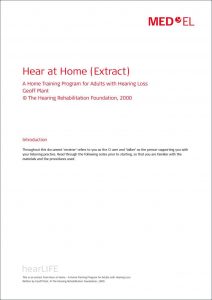MED-EL
Published Nov 27, 2019
Rehab For Adults: Auditory Training With Your Cochlear Implant Part 2

Last month, we gave you some tips and resources to kick off your listening practice. Those activities focused on common whole words, phrases, and sentences.
In this blog post we have another free resource to help you to continue with your listening practice. These activities focus on how you can practice listening for and discriminating specific speech sounds in words. You might have heard your rehabilitation specialists refer to this as ‘analytic’ auditory training.
Practice Listening For Specific Sounds
These activities get you started using several of the techniques and procedures which can be used with word lists focusing on different sounds. The activities provided target the ‘sh’ sound. This is a sound which may stand out in words and phrases for new cochlear implant users. But if there is a specific sound you would like more practice listening to you can easily create your own list of words and phrases to continue with!
You might find the activities a little difficult at first, but as you continue to practice you’ll start to become more comfortable with them.

Download the activity sheet now
Tips For Practicing
- If you are using a hearing aid in your other ear, remove it so you just listen with your audio processor.
- Don’t use lip reading to begin with, but add it if you need a clue.
- Start with EASIER variations of activities first and move through activities one by one.
- Ask your communication partner (family member or friend who is helping you with your listening practice) to use listening first when using the materials provided as this training aims to build your listening skills with your CI:
- LISTEN to the words (your communication partner points to each word/picture and says them)
- SAY (you say the word back to your communication partner)
- LISTEN & CHOOSE (your communication partner says one of the listed words again, you listen and choose which picture/word/sentence you heard)
- If the activities are difficult, add visual clues (lip reading, written text, gestures) where needed after you have had a chance to ‘listen first’.
- Remember, listening ‘mileage’ is important. Your brain needs time and practice to make sense of the information it is receiving from the cochlear implant.
- Listening practice with your CI can be tiring! Short bursts of practice, such as two 15-minute blocks per day is better than one 30-minute session.
How To Make Activities Easier Or More Difficult
As we mentioned in our post last month, there are a number of factors that will affect your outcomes with a cochlear implant and progress will vary from person to person. Don’t worry if you find these activities difficult. It just means you need more practice and time using your CI.
Here are five ways to make your listening activities easier or more difficult:
- Number of options: In the sentence building activity there are four sentences in the first set. Reduce or increase the number of sentences to make this easier or more difficult. You can use this rule in all activities.
- Clues: Add visual cues such as the written words, and then lip reading to make a task easier. Remove written text to make tasks more challenging.
- Sentence length: Longer sentences will be more difficult to understand than short phrases.
- Difference between words/sentences: Words and sentences that sound very similar for example, ‘edge’ vs ‘age’ are more difficult than words and sentences that have larger contrasts in sound and length such as ‘pear’ vs ‘banana’.
- Content: unfamiliar words are sentences are more difficult to understand than everyday familiar words and sentences.
Tune in next month to find out more about auditory training. Our post will include more resources to support you to continue your practice at home.
Read more about auditory training with your cochlear implant.
Learn more about what you can expect from a cochlear implant.
Take a look at these tips for talking on the telephone with a hearing implant.
MED-EL
Was this article helpful?
Thanks for your feedback.
Sign up for newsletter below for more.
Thanks for your feedback.
Please leave your message below.
Thanks for your message. We will reply as soon as possible.
Send us a message
Field is required
John Doe
Field is required
name@mail.com
Field is required
What do you think?
MED-EL


